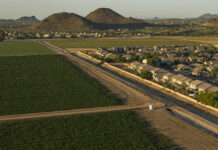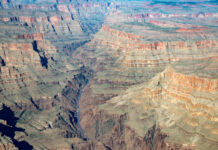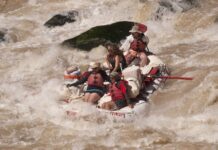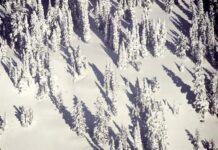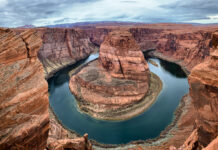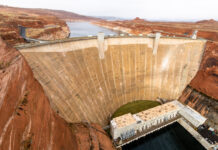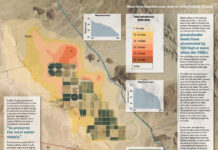Photos: Lees Ferry and Navajo Bridge, Arizona, December 2019
This page features photos of the Colorado River and Paria River at Lees Ferry, as well as nearby Navajo Bridge and Marble Canyon in Northern Arizona.
Lees Ferry marks the...
Arizona’s water supplies are drying up. How will its farmers survive?
By Stephen R. Miller, Food and Water Reporting Project
Photography by Bill Hatcher
You could almost visit Arizona without noticing it was a farming state. If you flew into Phoenix in an aisle seat,...
Colorado River Econ 101
By Kurt Repanshek, National Parks Traveler
From the high country in Rocky Mountain National Park a muddy flush of water rushes downstream, through western Colorado. It turns left, going south...
Climate change reducing Colorado River runoff
By Kurt Repanshek, National Parks Traveler
By mid-century, annual runoff into the Colorado River could be reduced by nearly a third as declining snowpack leads to greater evaporation of snowmelt,...
Not enough water and too many invasives at Glen Canyon National Recreation Area
Years of drought, upstream diversions and impoundments, and an overly optimistic forecast of Colorado River flows, have sapped the river once literally called Grand.
How climate change is redesigning Canyonlands National Park
A warming climate has been linked to human activity around the world, and has affected the Colorado River System as well. The impacts are substantial, from reduced water flows, threats to indigenous species and the influx of new invasive species along the river system.
Photos: Horseshoe Bend, Arizona, December 2019
This page features photos of the Colorado River at Horseshoe Bend, near Page, Arizona. This scenic vista in Glen Canyon National Recreation Area, located just downstream from Glen Canyon...
Photos: Glen Canyon Dam, Arizona, December 2019
This page features photos of Glen Canyon Dam and Lake Powell, near Page, Arizona. The 710-foot dam was built from 1956 to 1966. The reservoir is named for explorer...
As temperatures rise, Arizona sinks
The combination of groundwater pumping and warmer temperatures is shrinking aquifers and lowering water tables in Arizona.




